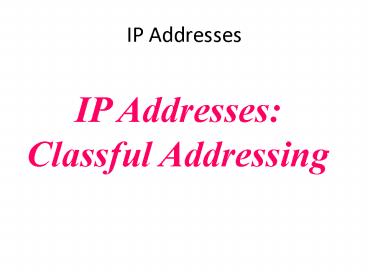IP Addresses - PowerPoint PPT Presentation
Title:
IP Addresses
Description:
Example 18. What is the network address if one of the addresses is 167.199.170.82/27? Solution. The prefix length is 27, which means that we must keep the first 27 ... – PowerPoint PPT presentation
Number of Views:77
Avg rating:3.0/5.0
Title: IP Addresses
1
IP Addresses
IP Addresses Classful Addressing
2
CONTENTS
- INTRODUCTION
- CLASSFUL ADDRESSING
- Different Network Classes
- Subnetting
- Classless Addressing
- Supernetting
- CIDR (classless Interdomain Routing)
3
4.1
INTRODUCTION
4
What is an IP Address?
An IP address is a 32-bit address.
The IP addresses are unique.
5
Address Space
..
..
addr1
addr15
addr2
..
..
..
addr226
addr41
addr31
..
..
6
Address space rule
..
..
addr1
addr15
addr2
..
The address space in a protocol That uses N-bits
to define an Address is 2N
..
..
addr226
addr41
addr31
..
..
7
IPv4 address space
The address space of IPv4 is 232 or
4,294,967,296.
8
Binary Notation
01110101 10010101 00011101 11101010
9
Figure 4-1
Dotted-decimal notation
10
Hexadecimal Notation
0111 0101 1001 0101 0001 1101 1110 1010
75 95 1D
EA
0x75951DEA
11
Example 1
Change the following IP address from binary
notation to dotted-decimal notation. 10000001
00001011 00001011 11101111
Solution
129.11.11.239
12
Example 2
Change the following IP address from
dotted-decimal notation to binary notation
111.56.45.78
Solution
01101111 00111000 00101101 01001110
13
Example 3
Find the error in the following IP
Address 111.56.045.78
Solution
There are no leading zeroes in Dotted-decimal
notation (045)
14
Example 3 (continued)
Find the error in the following IP
Address 75.45.301.14
Solution
In decimal notation each number lt 255 301 is
out of the range
15
Example 4
Change the following binary IP address
Hexadecimal notation 10000001 00001011
00001011 11101111
Solution
0X810B0BEF or 810B0BEF16
16
CLASSFUL ADDRESSING
17
Figure 4-2
Occupation of the address space
18
In classful addressing the address space is
divided into 5 classes A, B, C, D, and E.
19
Figure 4-3
Finding the class in binary notation
20
Figure 4-4
Finding the address class
21
Example 5
Show that Class A has 231 2,147,483,648
addresses
22
Example 6
Find the class of the following IP addresses
00000001 00001011 00001011 11101111 11000001
00001011 00001011 11101111
Solution
- 00000001 00001011 00001011 11101111
- 1st is 0, hence it is Class A
- 11000001 00001011 00001011 11101111
- 1st and 2nd bits are 1, and 3rd bit is 0 hence,
Class C
23
Figure 4-5
Finding the class in decimal notation
24
Example 7
Find the class of the following
addresses 158.223.1.108 227.13.14.88
Solution
- 158.223.1.108
- 1st byte 158 (128lt158lt191) class B
- 227.13.14.88
- 1st byte 227 (224lt227lt239) class D
25
IP address with appending port number
- 158.128.1.10825
- the for octet before colon is the IP address
- The number of colon (25) is the port number
26
Figure 4-6
Netid and hostid
27
Mask
- A mask is a 32-bit binary number.
- The mask is ANDeD with IP address to get
- The bloc address (Network address)
- Mask And IP address Block Address
28
Figure 4-10
Masking concept
29
Figure 4-11
AND operation
30
The network address is the beginning address of
each block. It can be found by applying the
default mask toany of the addresses in the block
(including itself). It retains the netid of the
block and sets the hostid to zero.
31
Default Mak
- Class A default mask is 255.0.0.0
- Class B default mask is 255.255.0.0
- Class C Default mask 255.255.255.0
32
5.3
CLASSLESS ADDRESSING
33
Slash notation is also called CIDR notation.
34
Example 17
A small organization is given a block with the
beginning address and the prefix length
205.16.37.24/29 (in slash notation). What is the
range of the block?
35
Solution
- The beginning address is 205.16.37.24. To find
the last address we keep the first 29 bits and
change the last 3 bits to 1s. - Beginning 11001111 00010000 00100101 00011000
- Ending 11001111 00010000 00100101
00011111 - There are only 8 addresses in this block.
36
Example 17 contd
We can find the range of addresses in Example 17
by another method. We can argue that the length
of the suffix is 32 - 29 or 3. So there are 23
8 addresses in this block. If the first address
is 205.16.37.24, the last address is 205.16.37.31
(24 7 31).
37
A block in classes A, B, and C can easily be
represented in slash notation as A.B.C.D/ n
where n is either 8 (class A), 16 (class B), or
24 (class C).
38
Example 18
What is the network address if one of the
addresses is 167.199.170.82/27?
Solution
The prefix length is 27, which means that we must
keep the first 27 bits as is and change the
remaining bits (5) to 0s. The 5 bits affect only
the last byte. The last byte is 01010010.
Changing the last 5 bits to 0s, we get 01000000
or 64. The network address is 167.199.170.64/27.

